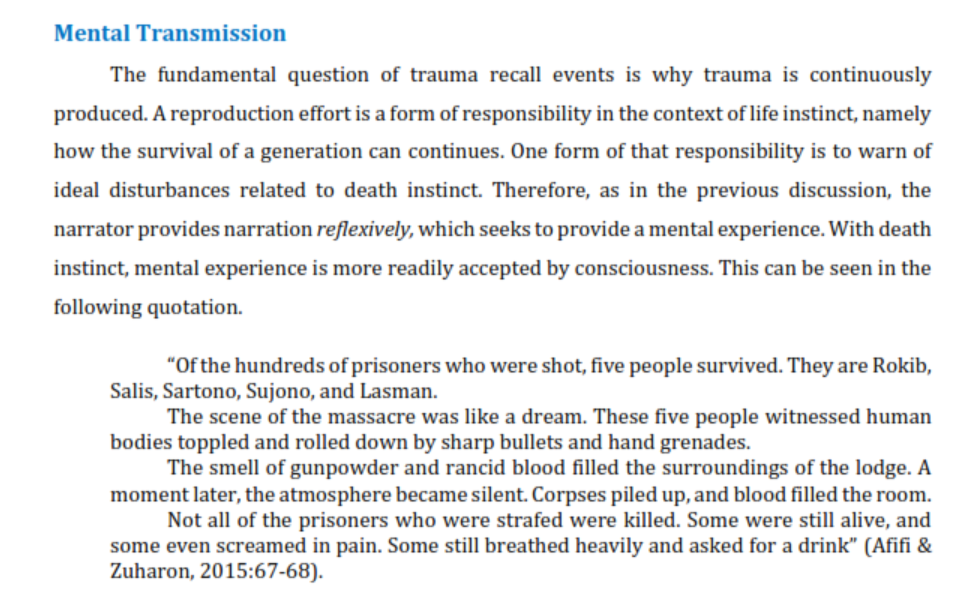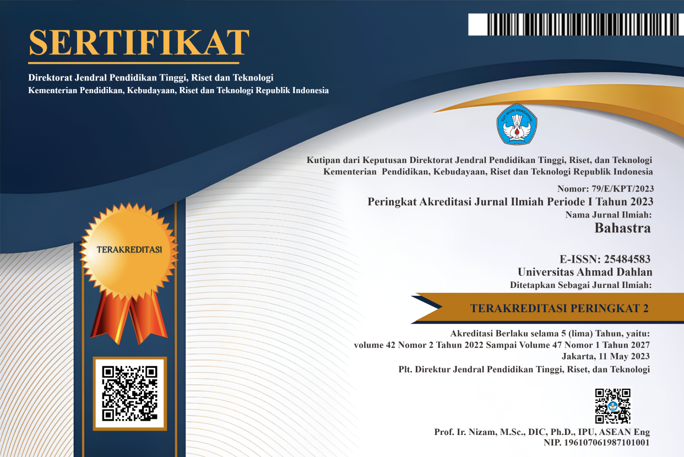Traumatic narrative of the pemberontakan PKI Madiun 1948 in the Ayat-Ayat yang Disembelih by Anaf Afifi and Thowaf Zuharon: A postmemory study
DOI:
https://doi.org/10.26555/bs.v43i2.403Keywords:
Ayat-Ayat yang Disembelih, Narasi trauma, Pemberontakan PKI Madiun 1948, postmemoryAbstract
This paper attempts to dismantle the pattern of trauma narratives developed in Indonesian literature by the second generation of the Pemberontakan PKI Madiun 1948. This second generation carries an Islamic narrative that is opposed to Communism. The narrative position of the Pemberontakan PKI Madiun 1948 is different from the G30S PKI 1965, in which the first PKI was the perpetrator, and the second PKI was the victim. The trauma narrative appears in the Ayat-Ayat yang Disembelih (2015) biography by Anaf Afifi and Thowaf Zuharon. The second generation lacks direct memory, which in Marianne Hirsch’s view, is postmemory. Accordingly, the theory used in this paper is Hirsch's postmemory, which believes that the second generation inherits trauma through investment in imagination, projection, and creation. The analytical method used is the methodological implications of postmemory theory with qualitative data. The pattern of the trauma narrative that emerges from the Islamic narrative to the PKI is; reflexive secondary first-person and mental transmission.
References
Afifi, A., & Zuharon, T. (2015). Ayat-Ayat yang disembelih. Jagat Publishing.
Boden, R. (2007). The “Gestapu” events of 1965 in Indonesia: New evidence from Russian and German archives. Bijdragen Tot de Taal-, Land- En Volkenkunde, 163(4), 507–528. https://doi.org/10.1163/22134379-90003693
Bui, L. (2016). The refugee repertoire: Performing and staging the postmemories of violence. Melusus, 41(3), 112–132. https://doi.org/10.1093/melus/mlw034
Choe, Y. (2013). Postmemory DMZ in South Korean cinema, 1999-2003. The Journal of Korean Studies, 18(2), 315–336. https://doi.org/10.1353/jks.2013.0013
Conroe, A. M. (2017). Moments of proximity: Former political prisoners, postmemory and justice in Indonesia. Asian Studies Review, 41(3), 352–370. https://doi.org/10.1080/10357823.2017.1334760
Cribb, R. (2001). Genocide in Indonesia, 1965‐1966. Journal of Genocide Research, 3(2), 219–239. https://doi.org/10.1080/713677655
_________. (2002). Unresolved problems in the Indonesian killings of 1965-1966. Asian Survey, 42(4), 550–563. https://doi.org/10.1525/as.2002.42.4.550
Efimova, L. M., & McVey, R. T. (2011). Stalin and the new program for the communist party of Indonesia. Indonesia, 91(April), 131–163. https://doi.org/10.5728/indonesia.91.0131
Eickhoff, M., van Klinken, G., & Robinson, G. (2017). 1965 Today: Living with the Indonesian massacres. Journal of Genocide Research, 19(4), 449–464. https://doi.org/10.1080/14623528.2017.1393931
Faruk. (2012). Metode penelitian sastra: Sebuah penjelajahan awal. Pustaka Pelajar.
Flick, U. (2007). Designing qualitative research. Sage Publications.
Gie, S. H. (2017). Orang-orang di persimpangan kiri jalan. Mata Bangsa.
Hirsch, M. (2012a). Family frames: Photography narrative and postmemory. Harvard University Press.
_________. (2012b). The generation of postmemory: Writing and visual culture after the holocaust. Columbia University Press.
Isnaeni, H. F. (2012). Jalan baru musso dalam peristiwa Madiun. Historia. https://historia.id/politik/articles/jalan-baru-musso-dalam-peristiwa-madiun-PeGqD/page/1
Kabir, A. J. (2004). Musical recall: Postmemory and the punjabi diaspora. Journal of Comparative Poetic, 24, 172–189. https://doi.org/10.2307/4047424
Knight, G. R. (2012). From merdeka! To massacre: The politics of sugar in the early years of the Indonesian republic. Journal of Southeast Asian Studies, 43(3), 402–421. https://doi.org/10.1017/S0022463412000318
Knox, K. E. (2014). Rapping postmemory, sampling the archive: Reimagining 17 October 1961. Modern & Contemporary France, 22(3), 381–397. https://doi.org/10.1080/09639489.2014.885004
Larkin, C. (2010). Beyond the war? The lebanese postmemory experience. Int.J.Middle East Stud, 42, 615–635. https://doi.org/10.1017/S002074381000084X
Leksana, G. (2019). Remembering the Indonesian genocide, 53 years later. Bijdragen Tot de Taal-, Land- En Volkenkunde, 175(1), 67–79. https://doi.org/10.1163/22134379-17501001
Lionis, C. (2014). A past not yet passed: Postmemory in the work of mona hatoum. Social Text, 32(2), 77–93. https://doi.org/10.1215/01642472-2419558
Matanasi, P. (2018). Musso gagal menciptakan ketertiban, akibatnya: Madiun affair 1948. Tirto.Id. https://tirto.id/musso-gagal-menciptakan-ketertiban-akibatnya-madiun-affair-1948-cYFA
Melvin, J. (2017). Mechanics of mass murder: A case for understanding the Indonesian killings as genocide. Journal of Genocide Research, 19(4), 487–511. https://doi.org/10.1080/14623528.2017.1393942
Moleong, L. J. (2017). Metodologi penelitian kualitatif. PT Remaja Rosdakarya.
Onghokham. (1978). Pemberontakan Madiun 1948: Drama manusia dalam revolusi. Prisma, (7), 57–70.
Poeze, H. A. (2020). Madiun 1948 PKI bergerak. Yayasan Pustaka Obor Indonesia dan KITLV.
Robinson, G. (2017). “Down to the very roots”: The Indonesian army’s role in the mass killings of 1965–66. Journal of Genocide Research, 19(4), 465–486. https://doi.org/10.1080/14623528.2017.1393935
Roosa, J. (2008). The truths of torture: Victims’ memories and state histories in Indonesia. Indonesia, 85, 31–49.
Swift, A. (1989). The road to Madiun: The Indonesian communist uprising of 1948. Cornell University.

Downloads
Published
Issue
Section
License
Copyright (c) 2023 Joko Santoso, Faruk, Novi Siti Kussuji Indrastuti

This work is licensed under a Creative Commons Attribution-ShareAlike 4.0 International License.

1.jpg)






